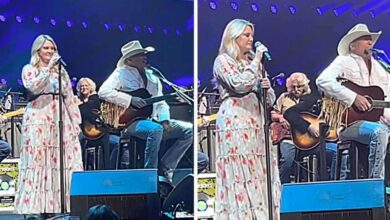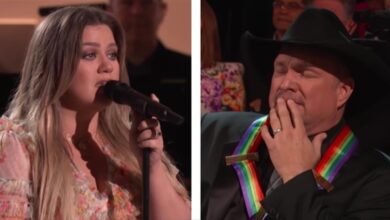This Popular Dance From The 1950s, Do You Remember It Now
In February 1958, a dance phenomenon took root in American high school gyms and sock hops, captivating the youthful spirit of the era, and embodying the carefree energy of rock ‘n’ roll’s early days. This dance was “The Stroll,” a line dance that rapidly became a defining element of teenage social gatherings. It originated within African American communities and swiftly gained immense popularity through television, most notably on Dick Clark’s “American Bandstand.” As teenagers across the nation watched and imitated the moves, The Stroll became synonymous with youthful exuberance and spontaneity, offering a communal experience that was easy to learn and infectious in its appeal.
The Stroll was not merely a dance but a cultural phenomenon that encapsulated the social dynamics of the 1950s. The dance structure was simple yet effective—two lines of participants facing each other with a narrow path in between allowed for individual expression while fostering a sense of unity. Couples would take turns strutting down the middle aisle, showcasing their unique styles and flair within the shared framework of the dance. This blending of individuality with collective participation resonated deeply with teenagers, many of whom were exploring their identities amidst the backdrop of a rapidly changing society.
Accompanying The Stroll was the song of the same name, performed by the Canadian vocal group The Diamonds. Renowned for their smooth harmonies and catchy doo-wop style, The Diamonds played an instrumental role in popularizing the dance. Their rendition of “The Stroll” transcended mere musical success; it became the an anthem for a generation, encapsulating the jubilance and rebellious spirit of the 1950s. Lead singer Dave Somerville’s rich baritone voice was particularly noteworthy, guiding dancers with his melodic delivery and infectious energy, making it nearly impossible to resist joining in on the fun.
As the dance soared in popularity, it became a staple at school dances and social events nationwide. Unlike many fads of the time, The Stroll possessed a quality that helped bridge racial and social divides during a period marked by significant segregation in the United States. Its uncomplicated steps rendered it accessible to a broad audience. Teenagers, dressed in their finest outfits, flocked to dance floors eager to engage in this cultural moment, embodying the confidence and optimism characteristic of post-war America. Thus, The Stroll emerged as not just a fun activity but a crucial social commentary reflecting shifting attitudes toward race, leisure, and community engagement.
With its meteoric rise in popularity, The Stroll also became emblematic of a generation yearning for self-expression and newfound freedoms. The presence of the dance across television and in music culture solidified its significance within American pop culture, creating lasting memories for many young people. Each performance of The Stroll transformed into a communal celebration, echoing the shared cultural experiences of youth during an era when music and dance served as vital outlets for expression and identity formation. It was indeed a ritual, rich with emotional connection and joy.
In retrospect, the emergence of The Stroll parallels a broader movement within American culture that leaned towards greater expression and inclusivity. The influence of African American traditions on rock ‘n’ roll and popular music was becoming increasingly acknowledged, as was the momentum of the civil rights movement, which was gathering strength during this time. Through dances like The Stroll, young people weren’t just participating in a latest craze; they were partaking in a more profound dialogue around community, identity, and the cultural shifts taking place in society.
The Diamonds, drawing influence from the doo-wop sound that characterized the decade, significantly contributed to the growth of this musical genre. They began their journey as a group in the early 1950s, quickly gaining fame for their compelling performances and harmonies. Their ability to captivate audiences with relatable themes of love and joy resonated deeply with the sentiments held by youth at the time. This connection to the younger generation granted The Diamonds a prominent place in popular music, allowing them to authentically represent the spirit of The Stroll and its cultural implications.
As time progressed, the significance of The Stroll continued to evolve yet remained relevant, often resurfacing in popular culture through revivals and adaptations in subsequent decades. Nowadays, the dance is commonly revisited during nostalgic gatherings and themed events, serving as a reminder of the joy and community music and dance can create. The essence of youthful exuberance and a sense of shared experience continues to resonate, enabling newer generations to engage with this slice of history in joyful celebration.
Media, including television and music, played pivotal roles in ensuring The Stroll embodied a transformative moment in American history. It captured the excitement and shifting social landscape of the late 1950s, symbolizing more than just an entertaining pastime for young people. It encompassed broader cultural shifts, reflecting the burgeoning desire for inclusion and expression that would characterize subsequent social movements. The interplay of music and dance in this era laid the groundwork for future generations to engage in creative self-expression, deeply connecting with their peers on dance floors and in social settings across the nation.
Thus, the narrative of The Stroll remains vibrant—a testament to the enduring power of music and movement to unify and inspire. It encapsulates a moment of cultural significance that, through the lens of retrospective appreciation, allows for reflection on the ability of art forms to bridge gaps and bring communities together. The Stroll symbolizes an era when enthusiasm for dance and music forged connections that crossed societal boundaries, celebrating a shared human experience that continues to resonate in the collective memory of American culture.
?si=CbHsPwTM-VodZAIG





